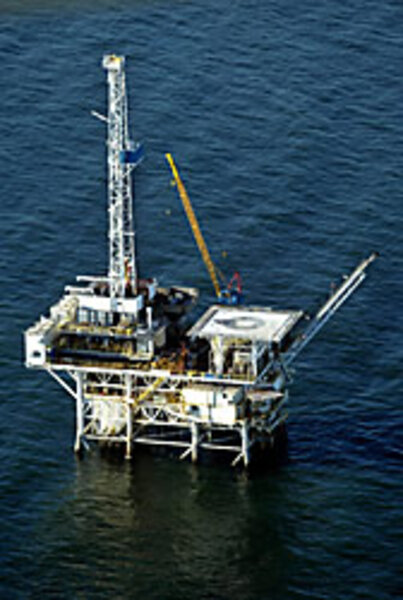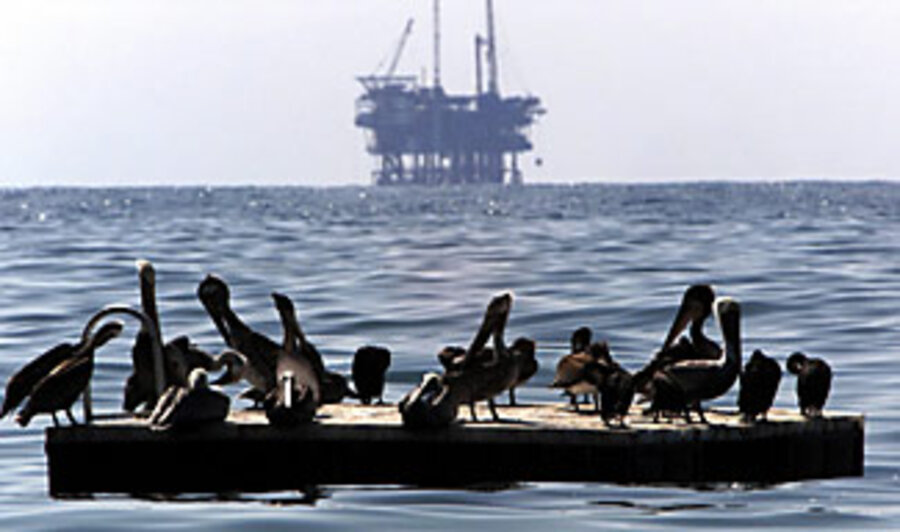Ooey, gooey oil seeps on the seafloor
Loading...
Santa Barbara, Calif., is famous for its golden beaches, wind-swept cliffs, and scenic views of the Pacific Ocean. But the city's postcard image hides a dirty secret: oil slicks – as colorful as a rainbow and as smelly as a gas station – float atop ocean waves just offshore.
Don't blame the oil rigs that dot the coastline, though. They may actually be helping keep the marine environment clean. In this topsy-turvy place, people aren't polluting the ocean – nature is.
Oil from underground deposits has been seeping into the Santa Barbara Channel for thousands of years. Every day, about 11 tons of oil droplets and oil-coated gas bubbles leak out of small holes or fissures in the seafloor.
Because oil is lighter than water, much of it rises to the ocean's surface and floats in thin, silvery slicks. But not all of it will reach the surface. About 15 percent will dissolve in the water in about a month. A small amount will sink into the mud and muck on the seafloor. And some of it will thicken into the gooey, black tar balls that wash ashore on Santa Barbara's tourist beaches.
Tar balls can be little black pebbles not much bigger than your fingernail, or they can be big, black blobs several inches across. Step on a sticky tar blob with your bare foot, and you'll wish you hadn't.
A long time forming
There are about 2,000 natural oil seeps in the vicinity of Santa Barbara. Where did they all come from? Over millions of years, oil-bearing rocks thrust upward by the San Andreas fault were exposed to the erosive forces of wind and rain. Oil-bearing sediments were swept into streams and rivers, where they settled in thick layers on the bottom of ancient oceans, lakes, and swamps.
Tectonic forces slowly folded and compressed the sediment into bituminous (oil-bearing) rocks. Heat in the earth's interior "cooked" the rocks, releasing liquid oil that collected in vast underground deposits.
Earthquakes opened deep cracks in the seafloor. Shaken by tremors and pulled by ocean tides, the oil seeped out of the cracks and floated up though the water like the gooey blobs in a lava lamp. Scientists think Santa Barbara's undersea oil seeps have been leaking this way for more than 20,000 years.
Useful to people
European explorers reported the seeps as early as 1775. In 1793, George Vancouver, an early European explorer to California, noted in his journal that the sea off Goleta, near what is today Santa Barbara, was "covered with a thick, slimy substance, which, when separated or disturbed by any little agitation, became very luminous...."
The oil seeps astonished the Europeans, who had never seen anything like them. But to the native Indians living in the area, they were as familiar as the sea itself. For generations, the Chumash, Yokuts, and other Indian tribes had used asphaltum (a natural tar that oozes from oil seeps) to help start fires and waterproof roofs, baskets, and canoes.
Asphaltum was used for face painting and as a base for jewelry inlaid with colorful stones. It was even used in games. In Huutch Uish, asphaltum-filled walnut shells were used as dice.
In the 1800s, pioneers used seep oil to grease their wagon wheels and farm equipment, and they burned it for light. By the 1860s, settlers were refining oil and using it as a crude pavement on roads. Miners dug pits and tunnels at seep sites, discovering oil, gas, and tar deposits.
By the 1900s, oil drilling was big business. Oil refined into gasoline and other fuels powered America's vehicles. And by the 1950s, offshore oil rigs were being built in the Santa Barbara Channel, removing millions of gallons of oil that would have naturally leaked from seeps.
Some animals adapt
While natural oil seeps have helped humans, they have not been as kind to animals. For thousands of years, animals became stuck and sank into ponds of liquid tar. The Rancho La Brea Tar Pits, a famous tar seep near Los Angeles, is a vast animal graveyard.
During the last Ice Age about 10,000 to 40,000 years ago, woolly mammoths, saber-toothed tigers, and even people became trapped in the tar. Thousands sank, and scientists called paleontologists now study their bones.
But other animals fared better. Generations of fish, dolphins, and whales that live in the Santa Barbara Channel have slowly adapted to the oil. Even though oil is poisonous, they tolerate it because seep oil is released in small amounts over time. Seawater mixes with the oil, diluting it and making it less harmful.
Seabirds living near the seeps have learned to swim or fly away from the slicks. That's good because birds and oil don't mix.
A bird's feathers insulate it against the cold, trapping its body heat and keeping it warm. Seabirds coated with oil try to clean their feathers by preening them with their bills. In doing so, they eat some of the oil, which is bad for them. But if they can't clean their feathers, the birds can't stay fluffy and warm in the cold water and could freeze.
Unfortunately, birds living in other parts of the channel don't seem to know about the dangers of the oil. When normal winds and currents change, the slicks spread elsewhere, and birds unfamiliar with oil get coated.
New discovery on the seafloor
Bottom-dwelling sea creatures have also adapted to the oil seeps. During a dive last year in a minisubmarine called Alvin, scientists saw a giant mound of tar near a seep. It was 262 feet across and 66 feet tall! It was overgrown with urchins and anemones and encircled by schools of fish.
Specialized bacteria that "eat" the oil lived nearby in slimy white mats. Clams, barnacles, and starfish that are specially adapted to survive near oil seeps thrived on the tar mountain. The scientists in Alvin had never seen anything like it. They said that the mound was a new kind of seafloor feature and that it probably started growing after an earthquake 23,000 years ago.
A word to the wise
Tar and oil seepage tends to increase in warm water. With global temperatures rising and the world's oceans warming, that means more tar balls on the beach. So if you and your family are planning to visit Santa Barbara, remember: Have fun on the beach, but watch where you step!
Some whale species may owe their survival more to a Polish pharmacist than to international agreements limiting commercial whaling.
In the early 1850s, Ignacy Lukasiewicz and another pharmacist, Jan Zeh, began experimenting with oil from natural seeps near Lviv, a city in modern-day Ukraine. They hoped to turn seep oil into an alternative to whale oil, which was expensive.
Whale oil was widely used as a fuel for lamps and a lubricant for machinery. The global whaling industry built hundreds of whaling boats, and many thousands of whales were slaughtered. It was very profitable.
Building on techniques perfected by Abraham Gesner in Canada, Lukasiewicz developed a method of turning gooey seep oil into clear kerosene fuel. Lukasiewicz's kerosene was easy to produce and it was cheaper than whale oil.
Interest in kerosene lamps grew when, on July 31, 1853, Lukasiewicz was asked to bring a lamp to the hospital so doctors could perform surgery after dark. The hospital staff were so impressed that they ordered some of his lamps.
Word spread, and soon much of Europe wanted kerosene lamps, too. People no longer wanted so much whale oil. It smelled bad and spoiled over time. Demand fell, and many factories that made whale oil closed.
By the late 1800s, commercial whaling had declined substantially, allowing some whale populations slowly to replenish.
• A guide to California's oil seeps is available from the United States Geological Service at http://seeps.wr.usgs.gov.
• To learn about oil's role in prehistoric California, visit the Page Museum at the La Brea Tar Pits: www.tarpits.org.
• Visit the kids' page on oil in the sea at the Global Marine Oil Pollution Information Gateway: http://oils.gpa.unep.org/kids/kids.htm.
• For science activities and puzzles about oil and the environment, see the Kids Playground page at www.mms.gov/omm/pacific/kids/kids.htm.







